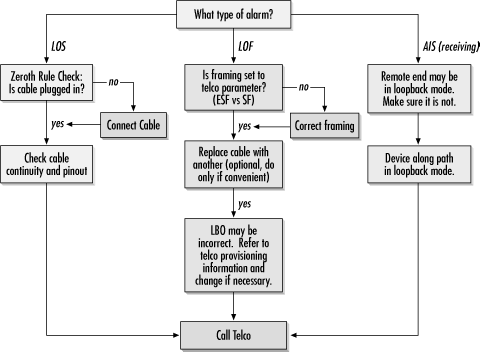Physical Layer Problems
Physical layer problems prevent the link layer from coming up. Generally speaking, physical layer problems are easy to spot because red lights will glow on the CSU/DSU until you have fixed them. Figure 11-5 shows the physical layer flowchart.

Figure 11-5. Physical layer flowchart
Red Alarm
A red alarm indicates a hard down on the T1 span. Either no incoming signal is being received (LOS—loss of signal) or no framing synchronization is possible (LOF—loss of framing). Do not be concerned if the red alarm is not cleared for several seconds after you plug in the cable. CSU/DSUs have a big job to do in sorting through the stream to find the framing bits and lock on to the synchronization pattern. Table 11-1 associates symptoms with possible causes and suggested actions.
Table 11-1. Physical layer diagnostic table
|
Symptom/indication |
Cause |
Corrective action |
|---|---|---|
|
No incoming signal (LOS) |
Cable is not connected to telco network |
Plug in the cable. |
|
Cable is bad |
Test the cable and replace it if necessary. Be sure to include the extended demarc in any testing. Extended demarc cabling should be appropriate for T1 applications. (Category 5 unshielded twisted pair is not!) Occasionally, the transmit and receive pairs may be reversed. | |
|
T1 circuit is bad |
Run a loopback test and call the telco/ISP with the results. | |
|
Unable to synchronize framing (LOF) |
Wrong frame ... |
Get T1: A Survival Guide now with the O’Reilly learning platform.
O’Reilly members experience books, live events, courses curated by job role, and more from O’Reilly and nearly 200 top publishers.

